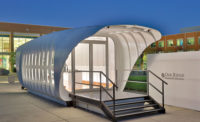Brooklyn, New York
At first glance, the work of Marc Fornes, founder of Brooklyn-based Marc Fornes/TheVeryMany, seems more like sculpture than architecture. His geometrically complex pieces, developed through computational design and fabrication, include museum installations, public art, and pop-up environments. They appear to take their cues from natural forms including those of crustaceans, plants, and wild animals. But Fornes, who is a native of France but moved to New York in 2006 to work for Skidmore, Owings and Merrill, insists that his approach is that of an architect rather than a sculptor. TheVeryMany's formal language, he says, is the product of exploiting curvature to make efficient structures. “With each project, we are trying to produce space and structure,” he explains.
Fornes's objects are usually comprised of thousands of flat elements—hence the name TheVeryMany. These are cut with a computer numerical control (CNC) machine from sheets of aluminum and are held together with rivets to form self-supporting skins. And, although they do not provide shelter in the conventional sense, the finished works define space and are often large enough to occupy. One example is Double Agent White, which Fornes designed and built in 2012 while an artist-in-residence at the Atelier Calder in Sach', France. Made of weblike aluminum surfaces describing nine intersecting spheres, it is now at the FRAC Centre in Orl'ans (record, October 2013, page 80), where visitors can walk under the roughly 11-foot-tall canopy, 20 feet in diameter, and circulate around its supporting “trunks.”
Although Fornes has not yet completed any buildings, his projects nevertheless involve a host of practical, real-world concerns. For instance, TheVeryMany served as executive architect for a pop-up store at Selfridges in London that was the product of a collaboration between artist Yayoi Kusama and Louis Vuitton. Here, Fornes had to devise components that would be small and light enough to easily maneuver inside the department store, but also large enough to minimize the need for on-site assembly. The resulting environment, which features elements reminiscent of pumpkins or sea urchins perforated by Kusama's signature dots, represents a technical innovation, says Fornes. It is the first self-supported carbon-fiber shell used in a work of architecture.
Fornes and his team of five employees—all of whom are trained as architects—perform almost every stage of the work themselves. They take each project from conceptual design through development of fabrication files, and they ultimately assemble the pieces on-site. Only one step—the cutting and milling—is performed by others. This process, says Fornes, gives him tight control over the finished product.
TheVeryMany has begun to win more traditional types of architectural commissions: the firm was recently selected for an open-air theater in Columbia, Maryland, and has a house under construction in Fornes's hometown of Strasbourg. Fornes hopes that as his projects grow in size and complexity, there will still be opportunities to build smaller-scale pieces. These are the kinds of projects, he says, that allow him to keep testing new ideas in design and fabrication.
Marc Fornes/TheVeryMany
FOUNDED: 2005
DESIGN STAFF: 6
PRINCIPALS: Marc Fornes
EDUCATION: Architectural Association School of Architecture, M.Arch., 2004; École Nationale Supérieure d'Architecture de Strasbourg, Architecte DPLG, 2001
WORK HISTORY: Zaha Hadid Architects, 2004'06; Skidmore, Owings & Merrill, 2006'08
KEY COMPLETED PROJECTS: Under Tension, Rennes, France, 2013; Les Danseurs du Tailor, Moss Bureau, New York, 2013; Chromatae, Denver Botanic Gardens, 2013
KEY CURRENT PROJECTS: MaHouse, Strasbourg, France, 2014; Amphitheater, Columbia, Maryland, 2015
WEB SITE: www.theverymany.com






















Post a comment to this article
Report Abusive Comment